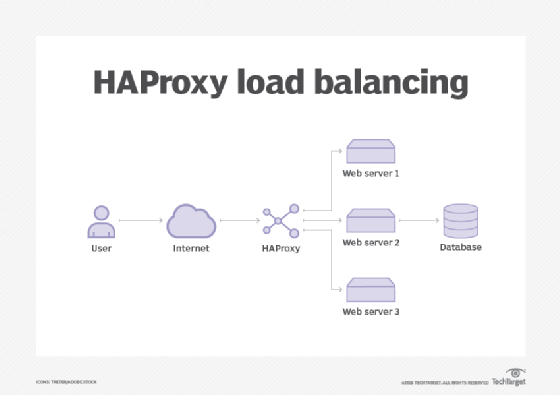HAProxy
What is HAProxy?
HAProxy is a high-performance, open source load balancer and reverse proxy for TCP and Hypertext Transfer Protocol (HTTP) applications. Users can use HAProxy to distribute workloads and improve website and application performance. Performance improvements include minimized response times and increased throughput. Users use HAProxy in high-traffic services, such as GitHub and Twitter.
Load balancers can distribute workloads across computers, networks, disk drives or central processing units. HAProxy, included in many distributions of Linux, is one of the leading standards in software load balancing.
Although HAProxy is open source, HAProxy Technologies offers a commercial option, called HAProxy Enterprise. It includes an enterprise suite of add-ons, expert support and professional services.

HAProxy features
HAProxy includes the following services:
- Layer 4 TCP and Layer 7 HTTP load balancing.
- Protocol support for HTTP, HTTP/2, gRPC and FastCGI.
- Secure Sockets Layer (SSL) and Transport Layer Security termination.
- Dynamic SSL certificate storage.
- Content switching and inspection.
- Transparent proxying.
- Detailed logging.
- Command-line interface (CLI) for server management.
- HTTP authentication.
- Multithreading.
- URL rewrites.
- Health checking.
- Rate limits.
The content switching feature enables users to select server pools on request. Additionally, setting up a transparent proxy lets users connect to a server with a client IP address. Content inspections enable users to block unexpected protocols. Users can use its detailed logging to view real-time request data. The CLI enables users to make changes, such as turning servers on or off. HAProxy is also scalable to connect to thousands of back ends.
HAProxy security
HAProxy users consider the tool secure because it has few vulnerabilities. HAProxy contains features that limit the attack surface in case of a security issue.
Some HAProxy security features are the following:
- Isolates itself with chroot.
- Drops to nonprivileged users and groups upon startup.
- Avoids disk access after initialization.
Users can also use HAProxy in areas to make other systems more secure. For example, HAProxy can inspect traffic and monitor the behavior of a client over a series of requests and then block the client if it seems malicious. Users can configure access control lists that define policies for when to permit access based on metadata found within a request. HAProxy also enables rate limits and IP blocklists and allowlists.
Editor's note: This article was republished in April 2023 to improve the reader experience.







